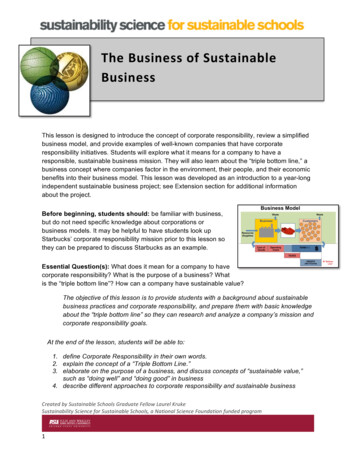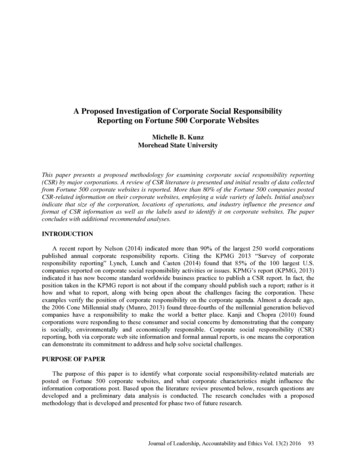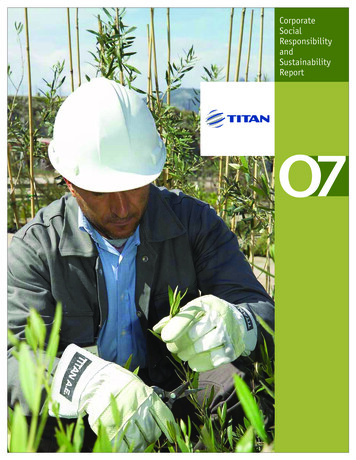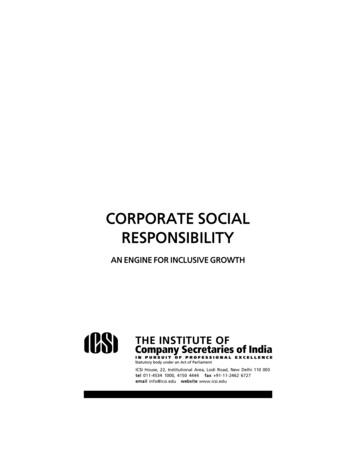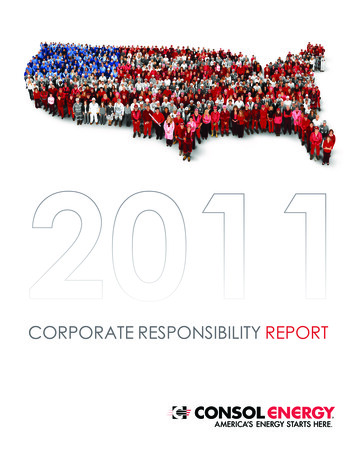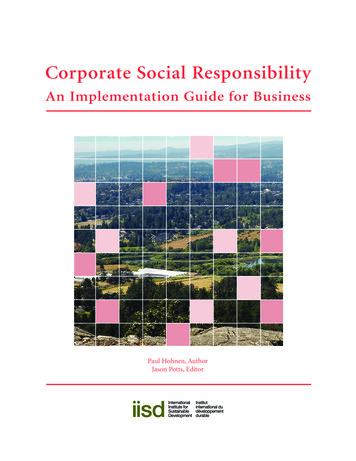
Transcription
Corporate Social ResponsibilityAn Implementation Guide for BusinessPaul Hohnen, AuthorJason Potts, Editor
Corporate Social ResponsibilityAn Implementation Guide for BusinessPaul Hohnen, AuthorJason Potts, Editor
iiCorporate Social Responsibility: An Implementation Guide for Business 2007, International Institute for Sustainable DevelopmentThe International Institute for Sustainable Development contributes to sustainable development by advancing policy recommendations on international trade and investment,economic policy, climate change and energy, measurement and assessment, and sustainable natural resources management. Through the Internet, we report on internationalnegotiations and share knowledge gained through collaborative projects with globalpartners, resulting in more rigorous research, capacity building in developing countriesand better dialogue between North and South.IISD’s vision is better living for all—sustainably; its mission is to champion innovation,enabling societies to live sustainably. IISD is registered as a charitable organization inCanada and has 501(c)(3) status in the United States. IISD receives core operating support from the Government of Canada, provided through the Canadian InternationalDevelopment Agency (CIDA), the International Development Research Centre (IDRC)and Environment Canada; and from the Province of Manitoba. The Institute receives project funding from numerous governments inside and outside Canada, United Nationsagencies, foundations and the private sector.International Institute for Sustainable Development161 Portage Avenue East, 6th FloorWinnipeg, ManitobaCanada R3B 0Y4Tel.: 1 (204) 958-7700Fax: 1 (204) 958-7710Web site: http://www.iisd.orgCorporate Social Responsibility: An Implementation Guide for BusinessISBN 978-1-895536-97-3Paul Hohnen, AuthorJason Potts, EditorThis document is available at http://www.iisd.org/pdf/2007/csr guide.pdf
Corporate Social Responsibility: An Implementation Guide for BusinessAcknowledgementThis guide reflects the inputs of many experts from around the world, including those listedin Appendix 1. IISD wishes to acknowledge in particular the lead authorship of theGovernment of Canada in the drafting of the original Canadian guide. The present guidewas written by Paul Hohnen and edited by Jason Potts of IISD.iii
ivCorporate Social Responsibility: An Implementation Guide for Business
Corporate Social Responsibility: An Implementation Guide for BusinessTable of ContentsPrefaceviiIntroduction1Responsible business is good business1About this guide3Part 1: An overview of corporate social responsibilityWhat is the business case for CSR?49Potential benefits of implementing a CSR approach11Real firms are reporting real benefits from CSR13What is the relationship between CSR and the law?15Part 2: Implementing corporate social responsibility18Task 1: Conduct a CSR assessment22Task 2: Develop a CSR strategy32Task 3: Develop CSR commitments42Key international CSR initiatives of governmental orintergovernmental bodies52CSR and Human Rights54Task 4: Implement CSR commitments57Task 5: Report and verify progress67Task 6: Evaluate and improve73Part 3: The importance of stakeholder engagement76Task 1: Identify stakeholders79Task 2: Understand the reason for stakeholder engagement80Task 3: Plan the engagement process80Task 4: Start the dialogue81Task 5: Maintain the dialogue and deliver on commitments81Appendix 1: External Multi-Stakeholder CSR Expert Advisory Group86Appendix 2: Corporate social responsibility organizations88Appendix 3: Key international CSR instruments93Appendix 4: Non-governmental CSR-related codes and standards initiatives98Appendix 5: National CSR guidance102Further reading103v
viCorporate Social Responsibility: An Implementation Guide for Business
Corporate Social Responsibility: An Implementation Guide for Business“Our biggest challenge this century is to take an idea that seemsabstract—sustainable development—and turn it into a reality for all theworld’s peoples.”Kofi Annan, former UN Secretary GeneralPrefaceOne of humankind’s greatest challenges this century will be to ensure sustainable, justand balanced development. The needs of current and future generations cannot be metunless there is respect for natural systems and international standards protecting coresocial and environmental values. In this context, it is increasingly recognized that the roleof the business sector is critical. As a part of society, it is in business’ interest to contribute to addressing common problems. Strategically speaking, business can only flourish when the communities and ecosystems in which they operate are healthy.This broad strategic context helps explain the growing appetite among businessesworldwide for authoritative information, company examples and advice about corporatesocial responsibility (CSR). This guide has been developed by the International Institutefor Sustainable Development (IISD) to help respond to that demand. Importantly, theguide should also be useful to the many firms that do not currently have formal CSR policies or programs in place. While not specifically developed for use by public agenciesand civil society organizations, the principles of CSR may also be helpful to them in theirown sustainability efforts.The guide, which draws heavily on a 2005 guide prepared by the Government of Canadafor a Canadian audience, aims to provide practical guidance to companies operating inthe international context.1 With this in mind, we have made a special effort to highlightissues and examples from around the world.The guide is primarily intended as an introduction to some of the existing CSR tools andapproaches which are currently being used. In publishing this guide, we aim to providea useful starting point for accessing the many CSR instruments currently available in themarketplace. Governments, multilateral organizations, non-governmental organizationsand other groups have devoted considerable time and energy to the promotion of corporate social responsibility giving rise to a vast repository of CSR initiatives, instrumentsand resources.Among the better known international instruments this guide draws on include: The Organisation for Economic Co-operation and Development (OECD)Guidelines for Multinational Enterprises; The International Labour Organization (ILO) Tripartite Declaration ofPrinciples concerning Multinational Enterprises and Social Policy and CoreLabour Standards; The UN Global Compact Principles;1 Corporate Social Responsibility: An implementation guide for Canadian business, 2005.vii
viiiCorporate Social Responsibility: An Implementation Guide for Business The Global Reporting Initiative (GRI) Sustainability Reporting Guidelines; The International Organization for Standardization (ISO) standards; The AccountAbility AA1000 Series; and The Social Accountability International SA8000 standard.It is hoped that businesses and other organizations interested in implementing a CSRapproach will use this guide as a point of departure for CSR design and implementation.The guide reviews key issues to consider, offers options for addressing them and refersto many specific tools that could be of most assistance. Actual implementation of anyspecific CSR activities will almost certainly involve the use of one or more of the tools referenced in this guide. Our purpose is to provide a framework for helping corporateCEOs, managers and employees navigate across the sea of existing CSR instruments.Readers should note that this guide considers CSR to be only one aspect of a comprehensive multi-stakeholder effort to improve environmental and social conditions and prevent harm. The complementary actions of all sectors of society—governments, non-governmental organizations, citizens and others—are also necessary.Firms that choose to implement a CSR approach should note that this will involve adynamic learning process, for which this guide is merely one source of information andassistance. Sustainable development and CSR are moving targets that cannot be fully“achieved” by one-time activities and decisions. Businesses—and other organizations—should approach CSR as a process of continual improvement, being constantly alert tonew issues and considerations. The challenges of sustainable development and marketdevelopments imply that a firm could adopt the approaches described in this guidetoday and face new challenges and opportunities tomorrow.In preparing the guide we have sought to use international examples of select best practices to illustrate the substance of the subject matter being presented. However, it shouldbe noted that the scope of the review is neither comprehensive nor complete with respectto all CSR activities and initiatives around the world. There are many examples that couldfurther substantiate the guide but for lack of time and resources could not be referenced.2 In an effort to ensure the guide’s accuracy and international relevance, we havesought input from an extensive external advisory group of CSR experts and users (seeAppendix 1). While the guide does not represent a consensus of the advisory group ormembers of the advisory group, it does try to reflect the diverse range of viewpoints andcultural contexts from which CSR is approached.Readers should not be put off by the guide’s length. While it can be read in full, it hasbeen developed so that separate sections can be read independently. This approachhas meant that there is some degree of repetition of general points, but it is hoped thiswill not be a deterrent to those reading it in full. Because it is published as a web-basedtool, readers will be able to dip into the most relevant parts (e.g., on guidance for smallbusiness) directly.2 A few examples from the East Asian context include: (1) the Singapore Compact that employs a tripartiteapproach involving business, government and labour, and Global Compact principles; (2) the ThailandLabour Standard (TLS) that consists of a government-led labour standard certificate system; (3) PROPERin Indonesia which is comprised of a government-led Environmental Performance Rating Programme inwhich the Ministry of Environment rates the environmental performance and pollution levels of businesses;(4) some Chinese initiatives such as the Nanching and Shanghai declarations in 2005 and the CSRBeijing Declaration in 2006; and, (5) within India, the Confederation of Indian Industries (CII).
Corporate Social Responsibility: An Implementation Guide for BusinessFinally, it should be noted that neither the initiatives nor companies referenced in thisguide are necessarily endorsed by IISD, or by any of the above-mentioned individualsand their organizations. The reader assumes full responsibility for using this guide in anyway.International Institute for Sustainable DevelopmentWinnipeg, ManitobaCanadaMarch, 2007ix
xCorporate Social Responsibility: An Implementation Guide for Business
Corporate Social Responsibility: An Implementation Guide for BusinessIntroductionResponsible business is good business“We are committed to creating economic value, but we are not indifferent to how we do it. . Progressive businesses are gaining competitiveadvantage by responding to societal signals. . We prosper by helpingsociety to prosper.”Idar Kreutzer, CEO Storebrand, 2005There is growing recognition of the significant effect the activities of the private sectorhave—on employees, customers, communities, the environment, competitors, businesspartners, investors, shareholders, governments and others. It is also becoming increasingly clear that firms can contribute to their own wealth and to overall societal wealth byconsidering the effect they have on the world at large when making decisions.Business opinion polls and corporate behaviour both show increased levels of understanding of the link between responsible business and good business. Also, investorsand financial markets are beginning to see that CSR activities that integrate broader societal concerns into business strategy and performance are evidence of good management. In addition to building trust with the community and giving firms an edge in attracting good customers and employees, acting responsibly towards workers and others insociety can help build value for firms and their shareholders.“There is no way to avoid paying serious attention to corporate citizenship: the costs of failing are simply too high. . There are countless winwin opportunities waiting to be discovered: every activity in a firm’svalue chain overlaps in some way with social factors—everything fromhow you buy or procure to how you do your research—yet very fewcompanies have thought about this. The goal is to leverage your company’s unique capabilities in supporting social causes, and improveyour competitive context at the same time. The job of today’s leaders isto stop being defensive and start thinking systematically about corporate responsibility.”Michael Porter, Professor, Harvard Business School, at the April 2005Business and Society Conference on Corporate Citizenship, sponsoredby the University of Toronto’s Rotman School of ManagementIt must be recognized up front that CSR still creates a degree of confusion and controversy. Is the promotion and implementation of socially and environmentally preferablecorporate conduct a function of business or government? Is the implementation of CSRpractices a cost or a value-enhancer? Is it just public relations? In part, the problemstems from definitional issues, and a perception in some quarters that CSR is more aboutphilanthropy, rather than “doing business” and responding to shareholder interests. Thecentral thesis of this guide is that CSR is an integral part of the new business model.1
2Corporate Social Responsibility: An Implementation Guide for BusinessProperly understood, CSR should be seen as the way that firms—working with thosemost affected by their decisions (often called “stakeholders”)—can develop innovativeand economically viable products, processes and services within core businessprocesses, resulting in improved environmental protection and social conditions.This approach manifests itself in many forms, including high profile statements made bymany corporate CEOs. Launching General Electric’s “Ecomagination” vision of “a cleaner,healthier world,” Chief Executive Jeffrey Immelt underlined the company’s commitment tofind the “big answers for the big questions”—climate change, health, water—and todevelop solutions, working in partnership with governments and civil society;3 in otherwords, aligning core business strategy with the changing social and environmental context.“We believe that the leading global companies of 2020 will be thosethat provide goods and services and reach new customers in ways thataddress the world’s major challenges—including poverty, climatechange, resource depletion, globalization, and demographic shifts.”Niall Fitzgerald, former CEO & Chairman, UnileverBusinesses are an integral part of the communities in which they operate. Good executivesknow that their long-term success is based on continued good relations with a wide rangeof individuals, groups and institutions. Smart firms know that business can’t succeed insocieties that are failing—whether this is due to social or environmental challenges, or governance problems. Moreover, the general public has high expectations of the private sector in terms of responsible behaviour. Consumers expect goods and services to reflectsocially and environmentally responsible business behaviour at competitive prices.Shareholders also are searching for enhanced financial performance that integrates socialand environmental considerations, both in terms of risk and opportunities.Governments, too, are becoming aware of the national competitive advantages to bewon from a responsible business sector.4 At the same time, leading industry associations, such as the World Business Council for Sustainable Development, have also suggested that countries as well as companies might gain a competitive advantage fromcorporate social responsibility. In much of the developing world, governments and business understand that their respective competitive positions, and access to capital,increasingly depends on being seen to respect the highest global standards.5Even companies which may have a good reputation can risk losing their hard-earnedname when they fail to put systematic approaches in place to ensure continued positiveperformance. The effect of a tarnished reputation often extends far beyond that one firm:entire sectors and, indeed, nations can suffer. Hardly a month goes by without someexample of a major corporation suffering a reduced market position as a result of questionable behaviour, with many others subsequently finding themselves to be a part of thecollateral damage. These firms frequently expend considerable time and money attempting to regain their reputation, with mixed results.3 Further details can be found on the General Electric Web site, http://ge.ecomagination.com.4 See “Responsible Competitiveness: Reshaping global markets though responsible business practices,”AccountAbility, December 2005, quoted above.5 See “Developing Value: The business case for sustainability in emerging markets,” 2002, a report by IFC,SustainAbility and Ethos.
Corporate Social Responsibility: An Implementation Guide for BusinessSo what can be done to increase the likelihood that firms can enhance their good reputation, and continue to demonstrate positive business, social and environmental performance?On a practical level CSR approaches need to be constructed by adapting best practices,existing initiatives and analyses to local contexts and situations. This guide aims to provide objective guidance on these matters within a larger sustainable development framework in a balanced manner.6About this guideThis guide can be used as a primer on corporate social responsibility. As such, it contains information on how to assess the effects of business activities on others, developand implement a corporate social responsibility strategy and commitments, and measure, evaluate and report on performance and engage with stakeholders.Senior managers in firms of all sizes—from large corporations to small and medium-sizedenterprises to micro-businesses—should find it valuable, as will management teams,board members and front-line employees, and industry association personnel who workwith businesses. It is hoped that the guide will also prove useful to those alreadyengaged in CSR activities. Finally, it is hoped that those outside the commercial world(e.g., government officials, representatives of non-governmental organizations and members of the public) will gain insights into the challenges firms face when addressing theeffect of their activities on society.The guide distils ideas and processes from a variety of sources, and is intended to besuggestive, not prescriptive. It has three parts: Part 1 is an overview of CSR—how it is defined, the business case for it andthe relationship between CSR and the law; Part 2 sets out a six-stage “plan, do, check and improve” implementationframework for a CSR approach. This part also features information particularto small business, indicated by the magnifying glass icon; and Part 3 looks at stakeholder engagement and the integral role stakeholderscan play in implementing an effective CSR approach.Five appendices contain supplementary information, including a list of key sources forfurther reading.Every effort has been made to provide up-to-date examples of CSR practices and initiatives. Nevertheless, readers are encouraged to communicate directly with relevant specialist organizations, industry associations and other experts to obtain the latest information on these and other initiatives.Questions, comments and suggestions concerning the guide should be sent to:Sustainable Markets and Responsible Trade ProgramInternational Institute for Sustainable Development2001 Marie Anne EstMontreal, Quebec H2H 1M56 A description of the business case for addressing sustainable development issues is contained in“Capitalism at the Crossroads,” by Stuart L. Hart, 2005.3
4Corporate Social Responsibility: An Implementation Guide for BusinessPart 1An overview of corporate social responsibilityWhat is corporate social responsibility?“Social responsibility (is the) responsibility of an organisation for theimpacts of its decisions and activities on society and the environmentthrough transparent and ethical behaviour that is consistent with sustainable development and the welfare of society; takes into accountthe expectations of stakeholders; is in compliance with applicable lawand consistent with international norms of behaviour; and is integratedthroughout the organisation.”Working definition, ISO 26000 Working Group on Social Responsibility,Sydney, February 2007Corporate social responsibility (CSR) is also known by a number of other names. Theseinclude corporate responsibility, corporate accountability, corporate ethics, corporatecitizenship or stewardship, responsible entrepreneurship, and “triple bottom line,” toname just a few. As CSR issues become increasingly integrated into modern businesspractices, there is a trend towards referring to it as “responsible competitiveness” or“corporate sustainability.”A key point to note is that CSR is an evolving concept that currently does not have a universally accepted definition. Generally, CSR is understood to be the way firms integratesocial, environmental and economic concerns into their values, culture, decision making,strategy and operations in a transparent and accountable manner and thereby establishbetter practices within the firm, create wealth and improve society. As issues of sustainable development become more important, the question of how the business sectoraddresses them is also becoming an element of CSR.The World Business Council for Sustainable Development has described CSR as thebusiness contribution to sustainable economic development. Building on a base of compliance with legislation and regulations, CSR typically includes “beyond law” commitments and activities pertaining to: corporate governance and ethics; health and safety; environmental stewardship; human rights (including core labour rights); sustainable development; conditions of work (including safety and health, hours of work, wages); industrial relations;
Corporate Social Responsibility: An Implementation Guide for Business community involvement, development and investment; involvement of and respect for diverse cultures and disadvantaged peoples; corporate philanthropy and employee volunteering; customer satisfaction and adherence to principles of fair competition; anti-bribery and anti-corruption measures; accountability, transparency and performance reporting; and supplier relations, for both domestic and international supply chains.Generally, CSR is understood to be the way firms integrate social, environmental and economic concerns into their values, culture, decisionmaking, strategy and operations in a transparent and accountablemanner, and thereby establish better practices within the firm, createwealth and improve society.7These elements of CSR are frequently interconnected and interdependent, and apply tofirms wherever they operate in the world.It is also important to bear in mind that there are two separate drivers for CSR. Onerelates to public policy. Because the impacts of the business sector are so large, andwith a potential to be either positive or negative, it is natural that governments and widersociety take a close interest in what business does. This means that the expectations onbusinesses are rising; governments will be looking for ways to increase the positive contribution of business. The second driver is the business driver. Here, CSR considerationscan be seen as both costs (e.g., of introducing new approaches) or benefits (e.g., ofimproving brand value, or introducing products that meet sustainability demands). Theremainder of this guide addresses the second of these drivers.Since businesses play a pivotal role both in job and wealth creation in society and in theefficient use of natural capital, CSR is a central management concern. It positions companies to both proactively manage risks and take advantage of opportunities, especially with respect to their corporate reputation and the broad engagement of stakeholders.The latter can include shareholders, employees,8 customers, communities, suppliers,governments, non-governmental organizations, international organizations and othersaffected by a company’s activities (see Part 3, which is exclusively devoted to stakeholder engagement).Above all, CSR is about sensitivity to context—both societal and environmental—andrelated performance. It is about moving beyond declared intentions to effective andobservable actions and measurable societal impacts. Performance reporting is all part7 In its latest working definition of the scope of “social responsibility,” the ISO 26000 Working Group onSocial Responsibility identifies organizational governance, environment, human rights, labour practices,fair operating practices, consumer issues and community involvement as core issues. Resolution 3,Sydney, 2 February 2007.8 In cases where employees have elected representatives, these should also be included in the consultation process. For the purposes of this guide, any reference to employees includes worker representativewhere these exist, and workers throughout the supply chain.5
6Corporate Social Responsibility: An Implementation Guide for Businessof transparent, accountable—and, hence, credible—corporate behaviour. There is considerable potential for problems if stakeholders perceive that a firm is engaging in a public relations exercise and cannot demonstrate concrete actions that lead to real socialand environmental benefits.Corporate responsibility is “the basis on which business renegotiates andaligns the boundaries of its accountability.”Responsible Competitiveness: Reshaping Global Markets ThoughResponsible Business Practices, AccountAbility, December 2005CSR can involve a wide range of stakeholdersSource: apj/stakeholder.txt/ FILE/stakeholder.txtA corporation’s stakeholders can include: shareholders, non-governmental organizations, business partners, lenders, insurers, communities, regulators, intergovernmentalbodies, consumers, employees and investors.Why has CSR become important?“In the flat world, with lengthy global supply chains, the balance ofpower between global companies and the individual communities inwhich they operate is tilting more and more in favor of the companies . As such these companies are going to command more power,not only to create value but also to transmit values, than any other institution on the planet.”9Thomas L. Friedman, The World is Flat, 2005.9 This conclusion appears to be supported by public opinion. The 2007 Edelman “Trust Barometer” foundthat a majority of respondents in North America (71 per cent) and Asia (72 per cent) thought that globalbusiness plays a role that no other institution can in addressing major social and environmental challenges. Fifty-seven per cent in the European Union and 63 per cent in Latin America also believe this tobe true.
Corporate Social Responsibility: An Implementation Guide for BusinessMany factors and influences have led to increasing attention being devoted to the role ofcompanies and CSR. These include: Sustainable development: United Nations’ (UN) studies and many othershave underlined the fact that humankind is using natural resources at a fasterrate than they are being replaced. If this continues, future generations will nothave the resources they need for their development. In this sense, much ofcurrent development is unsustainable—it can’t be continued for both practical and moral reasons. Related issues include the need for greater attentionto poverty alleviation and respect for human rights. CSR is an entry point forunderstanding sustainable development issues and responding to them in afirm’s business strategy. Globalization: With its attendant focus on cross-border trade, multinationalenterprises and global supply chains—economic globalization is increasingly raising CSR concerns related to human resource management practices, environmental protection, and health and safety, among other things.CSR can play a vital role in detecting how business impacts labour conditions, local communities and economies, and what steps can be taken toensure business helps to maintain and build the public good. This can beespecially important for export-oriented firms in emerging economies. Governance: Governments and intergovernmental bodies, such as the UN,the Organisation for Economic Co-operation and Development (OECD) andthe International Labour Organization (ILO) have developed various compacts, declarations, guidelines, principles and other instruments that outlinenorms for what they consider to be acceptable business conduct. CSRinstruments often reflect internationally-agreed goals and laws regardinghuman rights, the environment and anti-corruption. Corporate sector impact: The sheer size and number of corporations, andtheir potential to impact political, social and environmental systems relativeto governments and civil society, raise questions about influence andaccountability. Even small and medium size enterprises (SMEs), which collectively represent the largest single employer, have a significant impact.Companies are global ambassadors of change and values. How theybehave is becoming a matter of increasing interest and importance (see boxbelow). Communications: Advances in communications technology, such as theInternet and mobile phones, are making
IISD’s vision is better living for all—sustainably; its mission is to champion innovation, enabling societies to live sustainably. IISD is registered as a charitable organization in Canada and has 501(c)(3) status in the United States. IISD receives core operating sup-port from th




